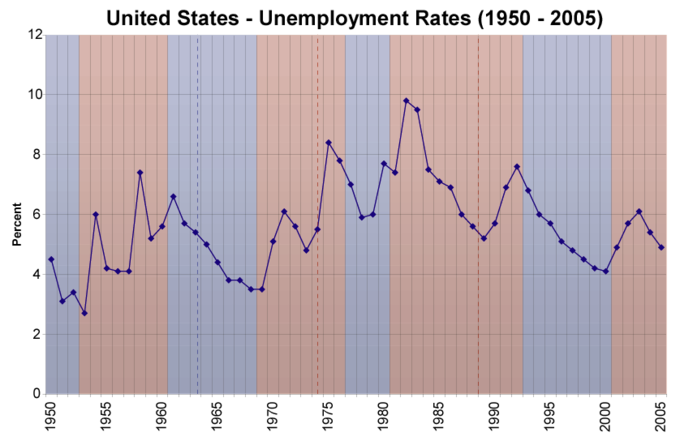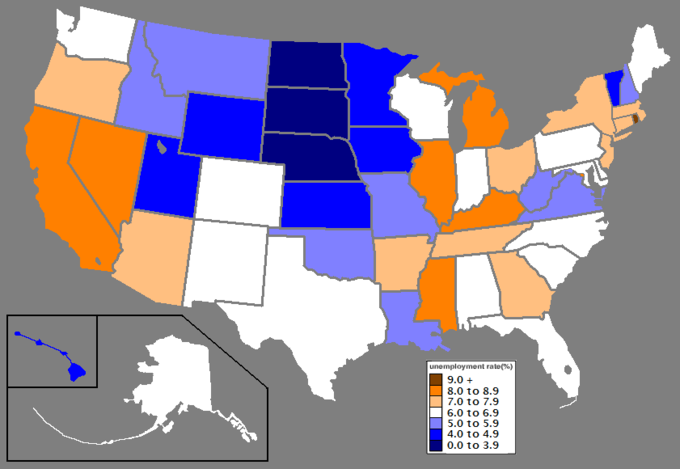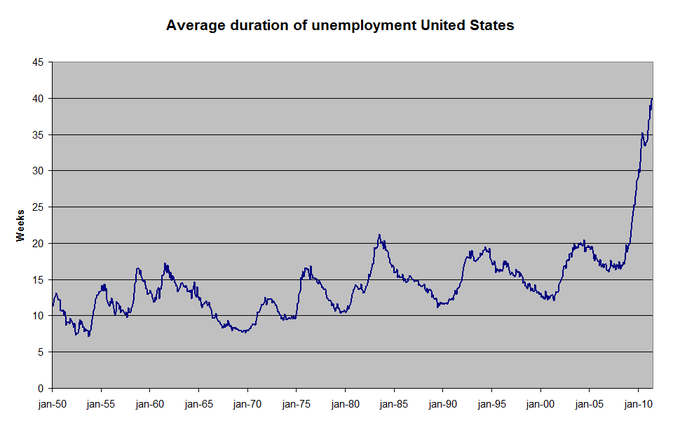8.1 – Introduction to Unemployment
Learning Objectives
- Classify the different measures and types of unemployment
- Define full employment
- Discuss structural unemployment, frictional unemployment, and the natural unemployment rate
Defining Unemployment
Unemployment, also referred to as joblessness, occurs when people are without work and are actively seeking employment. During periods of recession, an economy usually experiences high unemployment rates. There are many proposed causes, consequences, and solutions for unemployment.
Types of Unemployment
- Classical: occurs when real wages for jobs are set above the market-clearing level. It causes the number of job seekers to be higher than the number of vacancies.
- Cyclical: occurs when there is not enough aggregate demand in the economy to provide jobs for everyone who wants to work. Demand for goods and services decreases, less production is needed, and fewer workers are needed.
- Structural: occurs when the labour market is not able to provide jobs for everyone who wants to work. There is a mismatch between the skills of the unemployed workers and the skills needed for available jobs. It differs from frictional unemployment because it lasts longer.
- Frictional: the time period in between jobs when a worker is searching for work or transitioning from one job to another.
- Hidden: the unemployment of potential workers that is not taken into account in official unemployment statistics because of how the data is collected. For example, workers are only considered unemployed if they are looking for work so those without jobs who have stopped looking are no longer considered unemployed.
- Long-term: usually defined as unemployment lasting longer than one year.
Measuring Unemployment
Unemployment is calculated as a percentage by dividing the number of unemployed individuals by the number of all individuals currently employed in the workforce. The final measurement is called the rate of unemployment.

Effects of Unemployment
When unemployment rates are high and steady, there are negative impacts on the long-run economic growth. Unemployment wastes resources, generates redistributive pressures and distortions, increases poverty, limits labour mobility, and promotes social unrest and conflict. The effects of unemployment can be broken down into three types:
- Individual: people who are unemployed cannot earn money to meet their financial obligations. Unemployment can lead to homelessness, illness, and mental stress. It can also cause underemployment where workers take on jobs that are below their skill level.
- Social: an economy that has high unemployment is not using all of its resources efficiently, specifically labour. When individuals accept employment below their skill level the economies efficiency is reduced further. Workers lose skills which causes a loss of human capital.
- Socio-political: high unemployment rates can cause civil unrest in a country.
Reducing Unemployment
There are numerous solutions that can help reduce the amount of unemployment:
- Demand side solutions: many countries aid unemployed workers through social welfare programs. Individuals receive unemployment benefits including insurance, compensation, welfare, and subsidies to aid in retraining. An example of a demand side solution is government funded employment of the able-bodied poor.
- Supply side solutions: the labour market is not 100% efficient. Supply side solutions remove the minimum wage and reduce the power of unions. The policies are designed to make the market more flexible in an attempt to increase long-run economic growth. Examples of supply side solutions include cutting taxes on businesses, reducing regulation, and increasing education.
Defining Full Employment
Full employment is defined as an acceptable level of unemployment somewhere above 0%; there is no cyclical or deficient-demand unemployment.
Full Employment
In macroeconomics, full employment is the level of employment rates where there is no cyclical or deficient-demand unemployment. Mainstream economists define full employment as an acceptable level of unemployment somewhere above 0%. Full employment represents a range of possible unemployment rates based on the country, time period, and political biases.

Ideal Unemployment
Full employment is often seen as an “ideal” unemployment rate. Ideal unemployment excludes types of unemployment where labour-market inefficiency is reflected. Only some frictional and voluntary unemployment exists, where workers are temporarily searching for new jobs. This classifies the unemployed individuals as being without a job voluntarily. Ideal unemployment promotes the efficiency of the economy.
Lord William Beveridge defined “full employment” as the situation where the number of unemployed workers equaled the number of job vacancies available. He preferred that the economy be kept above the full employment level to allow for maximum economic production.
Non-Accelerating Inflation Rate of Unemployment (NAIRU)
The full employment unemployment rate is also referred to as “natural” unemployment. In an effort to avoid this normative connotation, James Tobin introduced the term “Non-Accelerating Inflation Rate of Unemployment” also known as the NAIRU. It corresponds to the level of unemployment when real GDP equals potential output. The NAIRU has been called the “inflation threshold. ” The NAIRU states the inflation does not rise or fall when unemployment equals the natural rate.
As an example, the United States is committed to full employment. The “Full Employment Act” was passed in 1946 and revised in 1978. It states that full employment in the United States is no more than 3% unemployment for persons 20 and older, and 4% for persons aged 16 and over.
Types of Unemployment: Frictional, Structural, Cyclical
In economics, unemployment is occurs when people are without work while actively searching for employment.
Unemployment
In economics, unemployment occurs when people are without work while actively searching for employment. The unemployment rate is a percentage, and calculated by dividing the number of unemployed individuals by the number of all currently employed individuals in the labour force. The causes, consequences, and solutions vary based on the specific type of unemployment that is present within a country.

Structural Unemployment
Structural unemployment is one of the main types of unemployment within an economic system. It focuses on the structural problems within an economy and inefficiencies in labour markets. Structural unemployment occurs when a labour market is not able to provide jobs for everyone who is seeking employment. There is a mismatch between the skills of the unemployed workers and the skills needed for the jobs that are available. It is often impacted by persistent cyclical unemployment. For example, when an economy experiences long-term unemployment individuals become frustrated and their skills become obsolete. As a result, when the economy recovers they may not fit the requirements of new jobs due to their inactivity.

Frictional Unemployment
Frictional unemployment is another type of unemployment within an economy. It is the time period between jobs when a worker is searching for or transitioning from one job to another. Frictional unemployment is always present to some degree in an economy. It occurs when there is a mismatch between the workers and jobs. The mismatch can be related to skills, payment, work time, location, seasonal industries, attitude, taste, and other factors. Frictional unemployment is influenced by voluntary decisions to work based on each individual’s valuation of their own work and how that compares to current wage rates as well as the time and effort required to find a job.
Cyclical Unemployment
Cyclical unemployment is a type of unemployment that occurs when there is not enough aggregate demand in the economy to provide jobs for everyone who wants to work. In an economy, demand for most goods falls, less production is needed, and less workers are needed. With cyclical unemployment the number of unemployed workers is greater that the number of job vacancies.
The Natural Unemployment Rate
The natural unemployment rate, sometimes called the structural unemployment rate, was developed by Friedman and Phelps in the 1960s. It represents the hypothetical unemployment rate that is consistent with aggregate production being at a long-run level. The natural rate of unemployment is a combination of structural and frictional unemployment. It is present in an efficient and expanding economy when labour and resource markets are at equilibrium. The natural unemployment rate occurs within an economy when disturbances are not present.
Key Takeaways
- Types of unemployment determine what the causes, consequences, and solutions. The types of unemployment include: classical, cyclical, structural, frictional, hidden, and long-term.
- Unemployment is calculated as a percentage by dividing the number of unemployed individuals by the number of all the individuals currently employed in the work force.
- When unemployment rates are high and steady, there are negative impacts on the long-run economic growth.
- Demand side and supply side solutions are used to reduce unemployment rates.
- Full employment represents a range of possible unemployment rates based on the country, time period, and political biases.
- Full employment is often seen as an “ideal” unemployment rate. Ideal unemployment excludes types of unemployment where labour-market inefficiency is reflected.
- The full employment unemployment rate is also referred to as “natural” unemployment.
- The Non-Accelerating Inflation Rate of Unemployment (NAIRU) corresponds to the unemployment rate when real GDP equals potential output.
- Structural unemployment focuses on the structural problems within an economy and inefficiencies in labour markets.
- Frictional unemployment is the time period between jobs when a worker is searching for or transitioning from one job to another.
- Cyclical unemployment is a type of unemployment that occurs when there is not enough aggregate demand in the economy to provide jobs for everyone who wants to work.
- Classical unemployment occurs when real wages for a jobs are set above the marketing clearing level.
- The natural unemployment rate represents the hypothetical unemployment rate that is consistent with aggregate production being at a long-run level.
Attribution
Except were otherwise noted, this chapter is adapted from “Introduction to Unemployment” In Economics (Boundless) by Boundless, licensed under CC BY-SA.
Original Source References
- unemployment. Provided by: Wiktionary. Located at: en.wiktionary.org/wiki/unemployment. License: CC BY-SA: Attribution-ShareAlike
- Unemployment. Provided by: Wikipedia. Located at: en.Wikipedia.org/wiki/Unemplo…ull_employment. License: CC BY-SA: Attribution-ShareAlike
- Boundless. Provided by: Boundless Learning. Located at: www.boundless.com//economics/…n/unemployment. License: CC BY-SA: Attribution-ShareAlike
- Full employment. Provided by: Wikipedia. Located at: en.Wikipedia.org/wiki/Full_employment. License: CC BY-SA: Attribution-ShareAlike
- Boundless. Provided by: Boundless Learning. Located at: www.boundless.com//economics/…ull-employment. License: CC BY-SA: Attribution-ShareAlike
- Unemployment types. Provided by: Wikipedia. Located at: en.Wikipedia.org/wiki/Unemplo…l_unemployment. License: CC BY-SA: Attribution-ShareAlike
- Natural rate of unemployment. Provided by: Wikipedia. Located at: en.Wikipedia.org/wiki/Natural_rate_of_unemployment. License: CC BY-SA: Attribution-ShareAlike
- Unemployment. Provided by: Wikipedia. Located at: en.Wikipedia.org/wiki/Unemplo…l_unemployment. License: CC BY-SA: Attribution-ShareAlike
- frictional unemployment. Provided by: Wiktionary. Located at: en.wiktionary.org/wiki/frictional_unemployment. License: CC BY-SA: Attribution-ShareAlike
- structural unemployment. Provided by: Wiktionary. Located at: en.wiktionary.org/wiki/structural_unemployment. License: CC BY-SA: Attribution-ShareAlike
Media Attributions
- Unemployment rates in the United States (1950 – 2005). © Aude is licensed under a CC BY-SA (Attribution ShareAlike) license
- Map of U.S. states by unemployment rate © Bullshark44 is licensed under a CC BY-SA (Attribution ShareAlike) license
- US average duration of unemployment © MartinD is licensed under a CC BY-SA (Attribution ShareAlike) license
- Stone Hall Adult Education Centre, Warwick Road, Acocks Green – sign © Elliott Brown is licensed under a CC BY (Attribution) license
Unemployment that occurs as workers move between jobs
A state when an economy has no cyclical or deficient-demand unemployment.
Unemployment that occurs because individuals lack skills valued by employers

